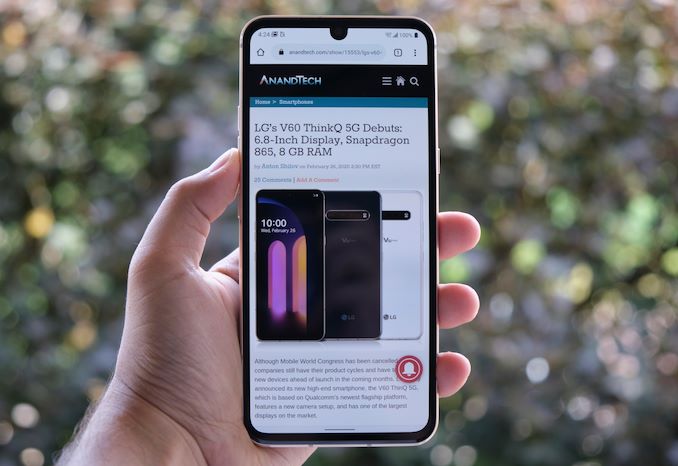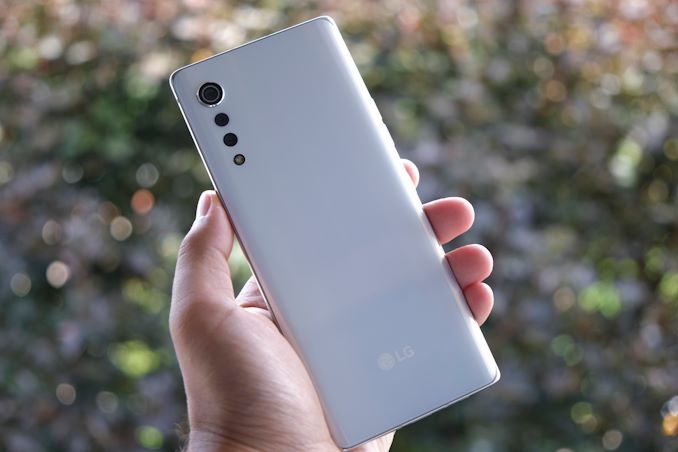The LG V60 and VELVET Review: A Classic & A Design Restart
by Andrei Frumusanu on July 15, 2020 9:00 AM ESTConclusion & End Remarks
Coming to the end of the review, we’re come to know to interesting devices from LG. The V60 and Velvet are two quite different devices that contrast LG’s seeming transition in device design, and for the most part, I’ve come to a generally positive impression from both phones.
Starting off with the LG V60, the first thing that is striking about the phone is that it’s a very non-contemporary design. Whilst most other manufacturers in 2020 have opted for curved screens and hole-punch front camera phones, LG has instead opted to seemingly remain in the past with a thick-bezeled notch design with a 2018-esque chamfered metal frame. Design is subjective, and practically besides of the ergonomics of a phone of this size, there’s nothing much wrong about keeping things simple like this – I’m pretty sure even a lot of people will enjoy the flat screen.
LG’s choice to go with a lower resolution screen when compared to the V50 is odd if one wouldn’t be familiar with LG past issues with battery life. I think the mobile division’s choice in downgrading the resolution is pretty much an admission that LG’s display division isn’t able to provide them with an efficient 1440p panel. I think this downgrade, as much as it’s painful for display fidelity, is the much better choice for the V60 as it finally solves the battery problem, and combined with the Snapdragon 865 and a 5000mAh makes the V60 amongst the longest lasting devices on the market today.
The lack of a high refresh-rate panel is a pity in 2020 – so that’s one of the compromises one has to make when going with the phone. Another big weakness is colour accuracy, and the V60 here is just horrible, but sadly we’ve come to expect that from LG phones.
Performance of the phone is great thanks to the S865 – it’s on par with other devices and results in a good user experience. I feel like LG’s software here can use a ton more polish in terms of their animations and general snappiness, but it’s not the phone itself which lacks processing power.
On the camera side of things, LG’s daylight pictures are excellent and easily amongst the top performers on the market. I really love what they did with the 64MP main camera sensor and it really is very detail-rich with good processing. The biggest weakness is low-light photography when it gets darker beyond a certain point, and the company’s lack of a proper computational photography night mode means it can’t compete with the rest of the pack when it gets very dark.
The LG Velvet is an interesting phone. First of all, LG’s redesign is a resounding success, and this is by far the sexiest LG phone we’ve come to experience in years. The company has always tried to be different in terms of their designs, but to be honest, there’s only so many ways to design a glass sandwich slab. For me the ergonomics of the phone are infinitely better than the V60 even though both devices share the same screen diagonal.
It’s also a 1080p screen, but here given that it’s a upper-mid-range / premium positioned device, I feel that it’s adequate enough for its class.
The Snapdragon 765 is new for a lot of people, and whilst it’s not my first encounter with the SoC, it’s the first comparison I was able to make against the S865 against a device from the same vendor, meaning the software stack and optimisations are similar. The end-result is probably a bit more disappointing than I had hoped it to be: On the CPU side, the chip generally performs in-between a Snapdragon 845 and a Snapdragon 855. Whilst I would no way say that it’s a bad user experience, there’s a clear difference in performance to the flagship V60.
On the GPU side, I feel like the difference is quite bigger, and here the phone performs in-between a Snapdragon 835 and 845 flagship phones when it comes to the performance, almost 2.5x slower than the Snapdragon 865 powered V60. That’s quite a starker difference, and if you’re a heavy gamer, it might not be the wisest purchase, versus say, just buying an older flagship phone.
Camera wise, the Velvet actually performed very well, and its best characteristics are that the processing is extremely similar to that of the V60, which means it’s quite excellent. Of course, the inferior sensor does mean slightly less details, dynamic range, and low-light photography is still a no-go, but at this price range it’s still reasonable enough.
Availability Is The Handicap
The LG V60’s release price was $899 which actually undercut a lot of other Snapdragon 865 phones in the market at the time, at least Samsung’s devices. The phone’s strengths are its outstanding battery life and a strong daylight camera. Weaknesses are a more lacklustre screen and a worse very low-light camera system. Unique things about the phone are its inclusion of a 3.5mm headphone jack. In general, the competition at this price would the OnePlus 8 Pro, which admittedly just offers a much better overall package, only sacrificing some battery life and the 3.5mm jack. I feel like LG would need a $100 price cut to make the V60 a more rationalised purchase.
The LG Velvet comes in at 599€. Whilst the phone its generally good for its price-point, the biggest issue I have with these premium devices is that 90% of the time you’re just better off buying last year’s flagship phones. A Galaxy S10 right now undercuts the Velvet at 555€ whilst being a much better phone with a better display, more performance, and overall better camera system. The only thing where the Velvet really is able to claim victory over last year’s devices is its 5G connectivity which future-proofs the phone significantly. In that sense, I also feel that the device is slightly overpriced as-is, and a 100€ reduction would alleviate any hesitations for its purchase. OnePlus’s upcoming Nord device seemingly will have very similar specifications to the Velvet while we’re expecting it to come at a lower price as well.
LG’s biggest issues today however isn’t merely pricing, but also availability. The V60 was never released in Europe and in the US it’s most commonly available only from select carriers. My review unit is actually T-Mobile branded phone and it comes with the usual bloatware associated with that.
The Velvet just outright isn’t available in the US, so you’ll have no luck in getting a device there. The phone was recently released in Europe with wider availability, as you can for example just buy a unit off LG directly from Amazon for example.
Overall, both phones aren’t the most competitive phones, but they’re still LG’s best phones they have made to date, and are both definitive improvements of the company’s past attempts. Let’s hope the Velvet’s fresh redesign can also be applied to other future LG devices.












81 Comments
View All Comments
kpb321 - Wednesday, July 15, 2020 - link
Why does it matter? Does anyone really regularly do anything with the USB port other than charge the device? Android doesn't have a local back up to a computer like iPhone/iTunes and even on that side it seems like most things happen automatically over wireless/wifi connection anyway. I doubt my wife could name the last time she hooker her android phone up to her computer. With her current phone I'm not even sure if she ever has hooked it up to a computer. For my iPhone I don't think I've ever hooked my current one up to my computer. Last time I upgraded I just used the wizard and it copied over what it needed to for the profile and then automatically reinstalled all the apps.flyingpants265 - Wednesday, July 15, 2020 - link
"Enthusiasts" will hate me, but the headphone jack should be kept, and the USB-C port should be completely eliminated. You can charge with any port.flyingpants265 - Wednesday, July 15, 2020 - link
USB-C is like an incremental upgrade to USB micro.if I'm actually designing something for scratch that would be perfect for phones, I'd have some kind of waterproof magnetic connector that doesn't have a million pins and giant connectors.
TheinsanegamerN - Thursday, July 16, 2020 - link
Magnetic would be an interesting addition, but USB also serves as the manner to bootstrap the device once its built and load the OS. So your magnetic connector would also need to do data.s.yu - Thursday, July 16, 2020 - link
Yes magnetics do data, the majority do.TheinsanegamerN - Thursday, July 16, 2020 - link
LOLWAT. How is that any better? The big issue with removing the headphone jack is that there is only 1 port, and you cant charge and listen to audio at the same time. Going to just a headphone jack wouldnt make it any better, and no you cannot just charge with "any port", the headphone jack was not designed to charge a phone, let alone charge while also streaming audio.flyingpants265 - Sunday, July 19, 2020 - link
So, you didn't actually read my comments?psychobriggsy - Wednesday, July 15, 2020 - link
What would be useful in a mobile phone review is additionally comparing to an older phone of a similar price (at the time) that someone would be upgrading from, hence their interest in looking at a review of a phone. How much faster is the device - is it even worth upgrading if the phone is otherwise okay?s.yu - Wednesday, July 15, 2020 - link
Sounds good except you'd need to compare multiple phones from multiple years, there's no telling if one upgrades annually, biennially, triennially, or...it goes on and on. With Anandtech's interface it's not realistic, but with Notebookcheck's at least you can manually add devices to a comparison list, though that would be once every section, e.g. if you added a device in the CPU section you'd need to add it again for a GPU or battery life comparison. Also older devices may not have been tested by the exact same testing methods, e.g. GB4 is obviously not comparable with GB5, crucially, battery tests are also updated.flyingpants265 - Wednesday, July 15, 2020 - link
What on earth are you even saying?